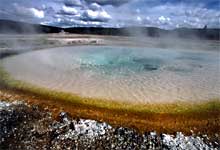|
Lobby > Exhibits > Hot Spring Ecology > Microbes > Microenvironments
Microbes
MICROENVIRONMENTS
In Yellowstone there are three main chemical types of hydrothermal environments that
are determined by the rock layers through which the heated ground water passes as it
rises to the surface. Different microorganisms thrive in each.
| Environment |
Description |
| Alkaline siliceous |
Water is rich in silica from traveling through rhyolitic lava flows within the
Yellowstone caldera. (pH of water: 8-11) |
| Acidic |
Gases, such as hydrogen sulfide, come into contact with oxygen in the water.
Microbes convert the hydrogen sulfide to sulfuric acid. (pH of water: 1-6) |
| Sulfide-rich carbonate |
The terraces at Mammoth Hot Springs are formed of travertine, a rock made of
calcium carbonate. Microbes may convert hydrogen sulfide to sulfuric acid,
but the carbonate acts like an antacid. (pH of water: 7)
|
Microbes thrive in each of these environments, but each microbial species requires
specific conditions for survival. Therefore, a microbe that is adapted to high levels
of hydrogen sulfide may be found near a sulfide-rich source pool, but not downstream
where the gas is gone, or in a spring where hydrogen sulfide is absent. Similarly,
microbes adapted to low pH conditions are not found in areas that are alkaline.
Temperature
 Each microbe species within a hydrothermal feature has specific temperature requirements.
Some live in the hottest water near the hot water source, while others inhabit the cooler
runoff channels. The upper temperature ranges of different microbial mats are marked by
distinct color changes, forming a living thermometer. In an alkaline siliceous hot spring, for example, pink, pale yellow, or cream colors
appear in the hottest areas, green indicates the next warmest areas, then yellow, orange,
and brown microbes appear in cooler portions of the runoff channels. Each microbe species within a hydrothermal feature has specific temperature requirements.
Some live in the hottest water near the hot water source, while others inhabit the cooler
runoff channels. The upper temperature ranges of different microbial mats are marked by
distinct color changes, forming a living thermometer. In an alkaline siliceous hot spring, for example, pink, pale yellow, or cream colors
appear in the hottest areas, green indicates the next warmest areas, then yellow, orange,
and brown microbes appear in cooler portions of the runoff channels.
|
You need to upgrade your Flash Player
|
Light
Different microbes also have varying light requirements. As a microbial mat grows,
the microorganisms underneath don't receive as much sunlight. Eventually they die and
are replaced by species capable of surviving in less light. Similar to forest ecology,
some microbial species thrive in the "canopy" closer to the sunlight, while others
flourish in the "under story."
Next |
1 > 2 > 3 > 4 > 5 > 6 > 7 > 8 | Return to: Hot Spring Ecology

|

This work is supported by


|
|

 Each microbe species within a hydrothermal feature has specific temperature requirements.
Some live in the hottest water near the hot water source, while others inhabit the cooler
runoff channels. The upper temperature ranges of different microbial mats are marked by
distinct color changes, forming a living thermometer. In an alkaline siliceous hot spring, for example, pink, pale yellow, or cream colors
appear in the hottest areas, green indicates the next warmest areas, then yellow, orange,
and brown microbes appear in cooler portions of the runoff channels.
Each microbe species within a hydrothermal feature has specific temperature requirements.
Some live in the hottest water near the hot water source, while others inhabit the cooler
runoff channels. The upper temperature ranges of different microbial mats are marked by
distinct color changes, forming a living thermometer. In an alkaline siliceous hot spring, for example, pink, pale yellow, or cream colors
appear in the hottest areas, green indicates the next warmest areas, then yellow, orange,
and brown microbes appear in cooler portions of the runoff channels.
